Here are some examples of vintage milk glass “utility” jars that held many types of products, especially creams (face cream, facial cream, peroxide cream, beauty cream, vanishing cream, baby cream) as well as other cosmetics, lotions, salves and ointments. Often, the bathroom and/or the lady’s bedroom dressing table would include a number of these kinds of jars at hand.
Most of those shown in the photos below date from the 1920s into the 1950s, although a few may be somewhat earlier or later. These types of glass jars were made in very large numbers and are often found in old trash dumps throughout the United States.
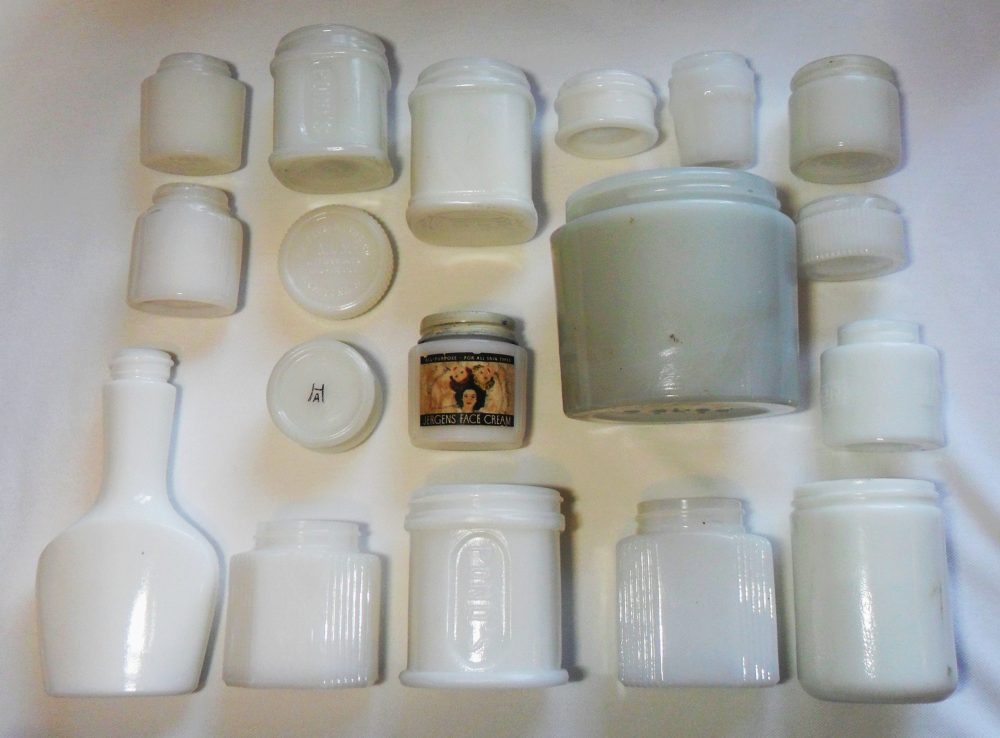
PHOTO ONE (Above)~ Row One: PONDS / 28 (on base); PONDS (on front); MELBA (on base); MUM / MFG. CO / PHILA. PA. (on base); MADE IN U.S.A.; MENLEY-JAMES / 1 / MADE IN U.S.A. / 1 / NEW YORK / LONDON (on base).
Row Two: MADE IN U.S.A. (on base); BRISTOL-MYERS CO. / MUM / NET WGT. .42 OZ. / MADE IN U.S.A. / NEW YORK N.Y. (on base); PONDS (large grayish white glass, marked on base); Unmarked, vertically ribbed.
Row Three: HA [Hazel-Atlas logo] on base, enhanced with marker to bring out detail; jar labeled “JERGENS FACE CREAM”, JERGENS marked on base; 5 / WOODBURY / 17.
Row Four: Unmarked bottle (this contained “Head & Shoulders Lotion Shampoo” and dates after 1961 – see post by Roger Whirley in the Comments section of this page); Vi-Jon (on base); PONDS (on front), HA logo on base; Vi-Jon (on base); Unmarked – thick heavy glass with grayish tint.
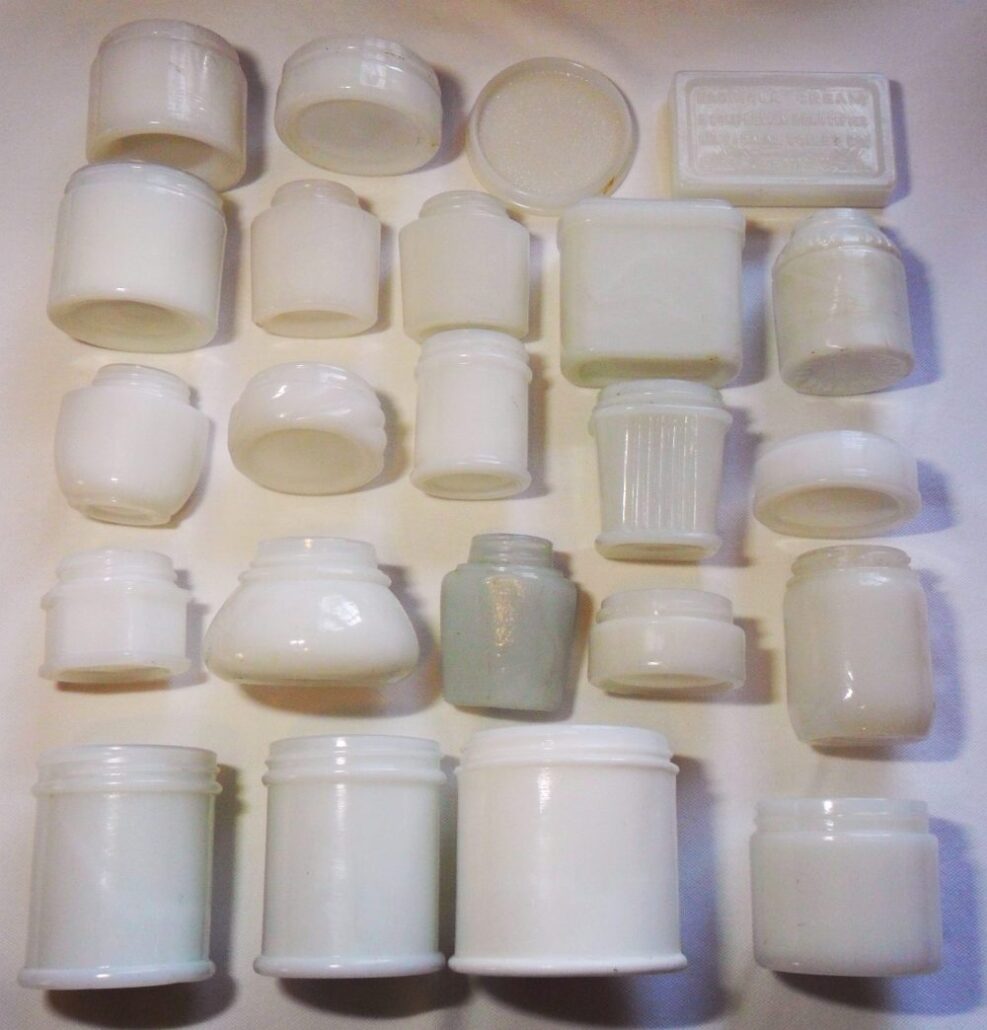
PHOTO TWO~ Row One: Unmarked; HA (Hazel Atlas logo, on base); 2505 (possible cosmetic lid?); NADINOLA CREAM / A COMPLEXION BEAUTIFIER / NATIONAL TOILET CO. / PARIS,TENN.U.S.A. (on base).
Row Two: 1 [mold number] on base; PONDS 31 (on base); PONDS 7 (on base); Unmarked; Unmarked [Rectangular “box” shaped jar]; INGRAMS MILK WEED CREAM (around shoulder), BOTTLE PATD / No 481953 (on base).
Row Three: Unmarked; Unmarked [ribbing around side]; Unmarked; Unmarked [vertical ribbing on two sides – possibly held a brand of foundation makeup or peroxide/vanishing cream]; 3857 [style number] HA logo.
Row Four: Unmarked (Hexagon-shaped base); Unmarked (possibly Johnson & Johnson?); Unmarked (blue-gray glass, probably cold cream); Unmarked; Unmarked.
Row Five: Unmarked “generic” cylindrical salve (this style often held Musterole, Mentholatum and Vico brand products); Unmarked (same as previous jar); MELBA (on base); V V 12 (mold number).
ADVERTISEMENT
Practically all of these have been found in trash dumps and excavations dating from the early through mid-20th century. The range of markings, brand names, shapes, sizes and styles of these and similar milk glass jars is astounding. A wide variety of brand names have been found embossed in the glass, usually placed on the base but often extending across the front or sides of the container. Of course, originally, virtually all of these vintage milk glass jars, whether marked or unmarked, would have carried an identifying paper label.
In some cases, comparing the exact shape of the jar with listings on eBay, etsy and Worthpoint (jars with the original label still affixed) will reveal possibilities as to the original contents. Another source of information would be advertisements published in vintage women’s magazines which sometimes featured photos of the jars with original labels.
Some brand names and company names that are frequently associated with vintage milk glass containers are: Ponds, Musterole, Mentholatum, Mum, Vico, Modjeska, Marinello, Rawleigh’s, Watkins, Sanitol, Carmex, Nadinola, Woodbury, J&J (Johnson & Johnson) and others. Examples with original labels will typically have more value, providing better information on provenance, age, and type of product involved.
Shown here (in the next two photos) is an unusual milk glass cosmetic jar (probably for cold cream, but possibly some other product) marketed by J.C. Penney. This is embossed with the name JACIEL on the bottom. The brand name “JACIEL” was used for a line of cosmetic products sold only through that department store. Judging from information on the following webpage, the Jaciel line was sold during the 1927 to 1934 time frame. http://collectingvintagecompacts.blogspot.com/2012/05/j-c-penney-and-his-butterfly.html Bottles, jars and other product packaging for the brand seem to be rather hard to find.
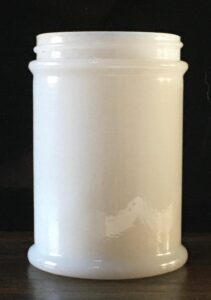
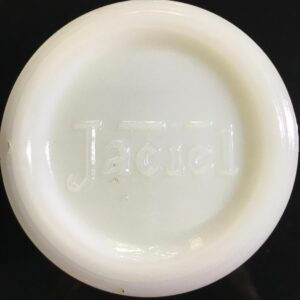
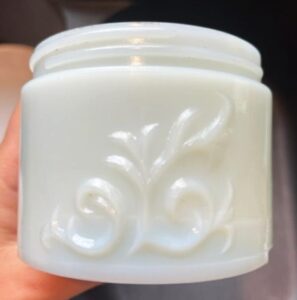
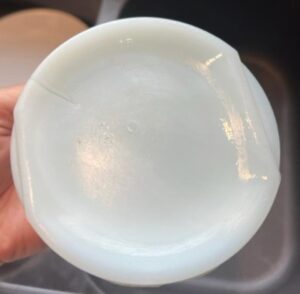
In the above two photos, we have an example of an “unknown” cosmetic jar found in Virginia, possibly that of an obscure brand of cold cream, with pictures sent to me by Angelina Knapp. If you have any information on the brand name of this product (perhaps you have an identical jar with the original label still intact?), please let us know! Thanks!
UPDATE 7/26/2024: I just received a post from reader Kathleen Audet; she writes: ” I just found an ad that shows Angelina Knapp’s jar with embossed leaf design. This jar has a metal white screw on lid. It identifies it as Granny Core 1950’s Milk Glass Vanity Jar Cold Cream HAND CREAM.” Thank you Kathleen!
Milk Glass Jar Manufacturers
The actual glass manufacturer of a majority of the milk glass containers found is unknown, or at least, at the present time there is not much easily obtainable evidence about who made them. Hazel-Atlas Glass Company was a huge manufacturer, making millions of these types of jars. If you have info on other makers, or can point to material online or in reference works that can help identify makers (actual glass makers, not distributors or retailers), please write!
Although there may be a few milk glass containers similar to these that are currently being made, it appears that the heyday of their production was during the 1920s-1950s. Unfortunately, they are often rather hard to date because a lot of these types of containers were made over several decades with little change in their basic appearance. During the 1960s and 1970s, many manufacturers and suppliers switched from glass over to plastic containers for their products.
See this page for basic background information on Milk Glass.
Please click here to go to the GLASS BOTTLE MARKS pages, page one.
My website Home Page (Welcome Page) is here.
ADVERTISEMENT

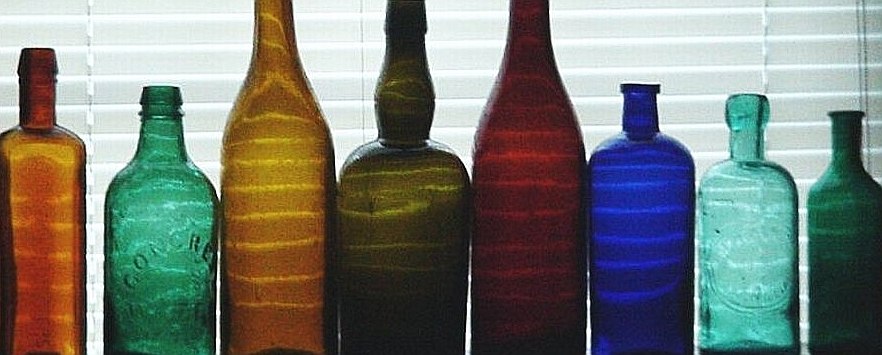
I just found an ad that shows Angelina Knapp’s jar with embossed leaf design. This jar has a metal white screw on lid. It identifies it as Granny Core 1950’s Milk Glass Vanity Jar Cold Cream HAND CREAM.
Hi Kathleen,
Thank you very much for your post! I appreciate that information, and I have added that to the text on this page.
Best regards,
David
Hi David, I found a Ponds 14 milk glass jar. How do I find someone that might want it? Does it have any value?
No label or lid but it is in good condition.
Hi Dave,
The PONDS jars in white milk glass were made over a very long period of time, in large numbers, and (I believe) in quite a few slightly different jar designs. Because they are so common, they have very little monetary value to collectors (at the present time, anyway). But I think the oldest ones are easily a century old. I’m sure there are milk glass collectors around the country who also have a selection of Ponds and other similar brand-name marked cold cream jars, salve jars, etc, along with their milk glass tableware collections. I’d suggest you start a bottle and jar collection of your own, or give it to a friend as a little gift or a piece of vintage decor, or maybe sell at a yard sale or list on Facebook Marketplace at a nominal price.
Take care,
David
Hi I have one very similar to one in the pics , it’s about 8 cm high with the lid.
It has marks on the bottom with what looks like a big A. A ‘C’ is in the top part and an ‘M’ in the bottom . It might be English in origin . I’m in NZ so we did get a lot of imported goods English & American ,the remains which turn up still .
Photo One lists: Row Four: Unmarked bottle (possibly lotion). This is a Head & Shoulders bottle and it first came out in 1961. I found one on May 18, 2023 and have been researching.
Thank You
Roger
Hi Roger,
Thanks for the information! I will make a slight edit in that photo caption. I saw a labeled example on Worthpoint and the label reads “Head & Shoulders Lotion Shampoo”.
Best regards,
David
My husband found one with a partial label. Do you know how many years they used milk glass for head and shoulders? The bottom of this one says T 3. Curious as to when mine was made. Thank you
Hello Mandy,
I have to be honest and tell you “I don’t know”. In general, many household and cosmetic products began changing over from glass to plastic containers in the 1960s and 1970s. I did a search on the Worthpoint site and found many past listings of Head & Shoulders shampoo bottles – in plastic as well as a few in white milk glass. The H&S shampoo was also packaged in small “squat” milk glass jars. If I had to hazard a guess, I would say most of their milk glass containers date before around 1972, give or take.
I am sure someone out there has a better idea on this than I do. Perhaps someone will see this thread and chime in with more information for us! One bit of trivia, that may or may not be of any help: if a label is still intact, always look closely for the mailing address of the company, and if there is a zip code included, the bottle or jar would have to date from 1963 or later, as that was the year when zip codes were officially instituted in the United States.
Best regards,
David
I have just found the same unidentified cold cream milk glass jar with the leaf on the side! Found in a creek dump from the 30s-50s in Illinois.
Thank you Haley for your post!
David
Hi! So glad I came across this. I have a used la Mer porcelain jar and have been looking everywhere for info on how to remove the labeling from the outside. It’s definitely not a sticker, but I’m afraid to scratch at it as well. Wondering if you have any suggestions?
Hi Andrea,
My suggestion would be to NOT remove the label! If you remove the label (which might be a type of ACL – Applied Color Labeling) – you reduce the value of the empty container to collectors – and it becomes just another unmarked “generic” milk glass jar. That’s my opinion anyway!
Thanks for writing~
David